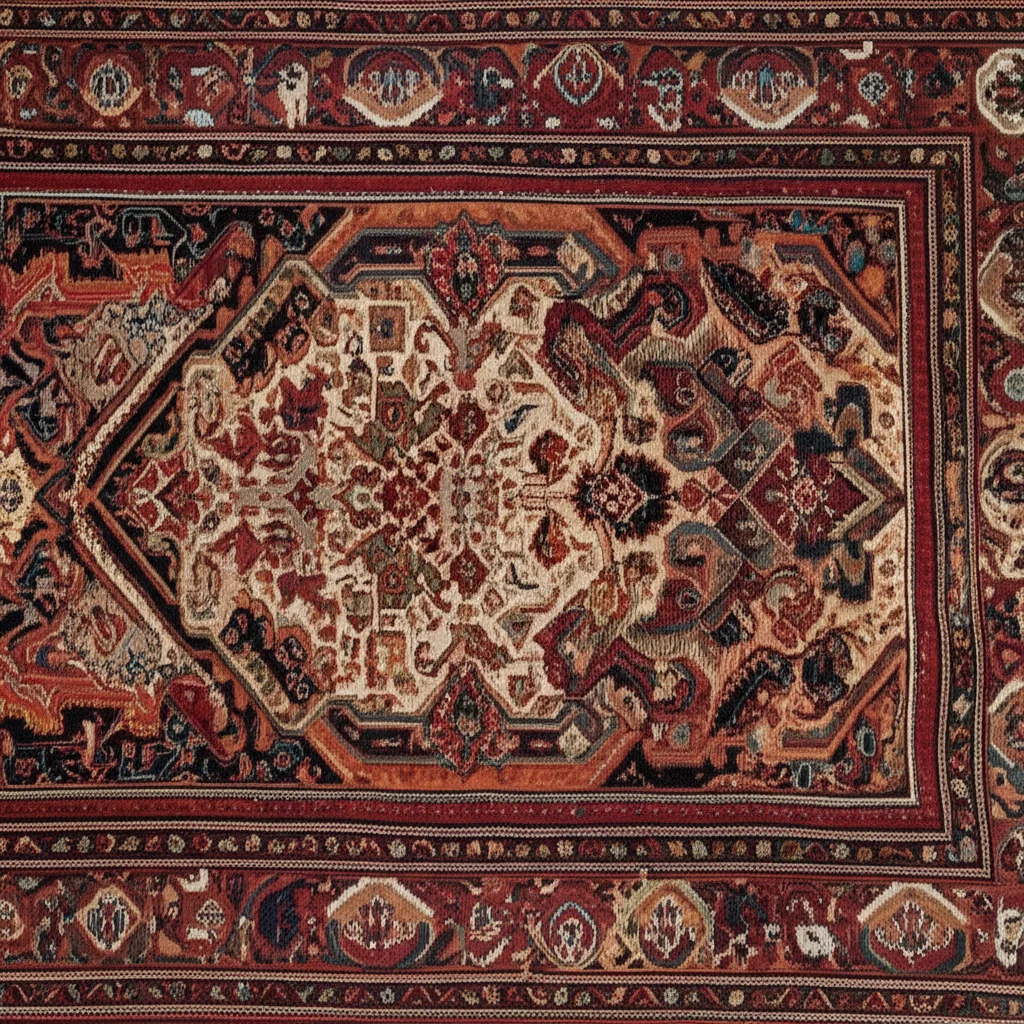· Todd Martin · Home & Living · 15 min read
What Is The Difference Between Turkish And Persian Rugs

What Is The Difference Between Turkish And Persian Rugs: A Complete Guide
Introduction
When shopping for an elegant floor covering to enhance your home’s aesthetic, you’ll likely encounter two prestigious options: Turkish and Persian rugs. These handcrafted masterpieces represent centuries of artistic tradition, yet they possess distinctive characteristics that set them apart. Understanding the difference between Turkish and Persian rugs can help you make an informed decision when investing in these timeless pieces. In this comprehensive guide, we’ll explore their unique qualities, from weaving techniques and design elements to materials and cultural significance.
Key Takeaways:
- Turkish rugs feature symmetrical (Turkish) knots while Persian rugs use asymmetrical (Persian) knots
- Persian rugs typically have more intricate designs with curvilinear patterns while Turkish rugs often feature geometric motifs
- Both styles have distinct regional variations that impact their appearance and value
- Quality indicators include knot density, materials used, and craftsmanship
- Proper care and maintenance can extend the lifespan of both rug types for generations
What’s the Difference Between Turkish and Persian Rugs?
Turkish and Persian rugs differ primarily in their knotting techniques, design motifs, and regional origins. Persian rugs (from Iran) typically feature asymmetrical knots, curvilinear floral designs, and higher knot counts. Turkish rugs (from Turkey) use symmetrical knots, display more geometric patterns, and often incorporate prayer niche designs reflecting Islamic influence.
Historical Background of Turkish and Persian Rugs
Origins and Evolution of Persian Rugs
Persian rug-making dates back over 2,500 years, with the earliest known Persian carpet—the Pazyryk carpet—discovered in Siberia dating to the 5th century BCE. Throughout history, Persian rugs have been treasured as luxury items, with their golden age occurring during the Safavid Dynasty (1501-1736). During this period, royal workshops were established, leading to remarkable innovations in design and technique.
Persian rug-making flourished across various regions of modern-day Iran, each developing distinctive styles. Major centers included Isfahan, Tabriz, Kerman, and Kashan. The tradition was passed down through generations, with designs reflecting the cultural, religious, and artistic sensibilities of their respective regions.
Today, authentic Persian rugs remain highly sought after for their exceptional quality and artistic value. While modern production methods have evolved, many artisans still create rugs using traditional techniques that have remained largely unchanged for centuries.
Origins and Evolution of Turkish Rugs
Turkish carpet weaving has equally ancient roots, with evidence suggesting the craft dates back to at least the 13th century, though likely much earlier. The tradition flourished under the Ottoman Empire, which ruled from the 14th to early 20th century. Turkish rugs gained international recognition through trade routes and became prized possessions among European nobility and wealthy merchants.
Major Turkish rug-making centers included Hereke, Oushak, Konya, and Bergama. Each region developed distinctive patterns and techniques that reflected local traditions and available materials. Turkish rugs also played important cultural and religious roles, with prayer rugs (sajjadah) being particularly significant in Islamic practice.
In recent centuries, Turkish rug-making has adapted to changing market demands while preserving traditional craftsmanship. Today, both antique and new Turkish rugs are valued for their distinctive aesthetic qualities and durability.
Weaving Techniques and Construction
The Turkish Knot vs. Persian Knot
One of the most fundamental differences between Turkish and Persian rugs lies in their knotting techniques:
Turkish (Ghiordes) Knot: Also known as the symmetrical knot, this technique involves wrapping yarn around two adjacent warp threads and drawing the ends back between them. This creates a stronger, more durable knot that produces a slightly thicker, sturdier rug. The symmetrical nature of this knot gives Turkish rugs their characteristic look and feel.
Persian (Senneh) Knot: This asymmetrical knotting technique wraps yarn around one warp thread and then passes under the adjacent warp thread. This allows for greater precision and enables weavers to create more intricate, detailed designs. Persian knots produce rugs with higher knot counts and finer detailing.
These different knotting methods significantly impact not only the appearance but also the texture and durability of the finished rugs.
Materials and Dyes Used
Both Turkish and Persian rug traditions utilize similar materials, but with some notable distinctions:
Wool: The primary material for both traditions, though the quality varies by region. Persian rugs often use Kork wool (from the neck and shoulders of sheep), known for its softness and luster. Turkish rugs frequently use Anatolian wool, prized for its durability.
Silk: Used in the finest examples of both traditions, silk allows for incredibly detailed designs with higher knot counts. Persian silk rugs from regions like Qum and Isfahan are particularly renowned. Turkish silk rugs from Hereke represent some of the finest examples of Turkish weaving.
Cotton: Often used for the foundation (warp and weft) in both traditions, providing stability to the structure.
Dyes: Traditionally, both used natural dyes derived from plants, insects, and minerals. Persian rugs typically feature a broader color palette with subtler color gradations. Turkish rugs often display bolder, more contrasting colors. Modern rugs may incorporate synthetic dyes, though premium pieces still favor natural dyeing methods.
The combination of materials and dyes significantly influences both the appearance and longevity of these handcrafted treasures.
Design Elements and Patterns
Characteristic Persian Rug Designs
Persian rugs are internationally acclaimed for their intricate, often curvilinear designs that demonstrate remarkable artistic sophistication:
Floral Patterns: Persian rugs frequently feature elaborately rendered floral motifs, including palmettes, rosettes, and vine scrolls. These botanical elements may be highly stylized or more naturalistic depending on the region.
Medallion Designs: A central medallion surrounded by coordinating corner pieces represents one of the most recognizable Persian design formats, particularly in rugs from Tabriz and Isfahan.
Hunting Scenes: Some Persian rugs, especially from regions like Kashan and Isfahan, depict elaborate hunting scenes with detailed renderings of animals and hunters.
Garden (Paradise) Designs: These distinctive patterns divide the rug into quadrants representing the four gardens of paradise, often with water channels and abundant plant life.
Herati Pattern: This widely used design element features a central rosette surrounded by curved leaves, creating a delicate, repeating pattern.
The color palette of Persian rugs tends toward rich jewel tones including deep reds, blues, and ivories, with complex color combinations and subtle gradations that create visual depth.
Characteristic Turkish Rug Designs
Turkish rugs display equally beautiful but distinctly different design sensibilities:
Geometric Patterns: Turkish rugs characteristically feature bold geometric motifs including diamonds, hexagons, and octagons arranged in repeating patterns.
Prayer Designs: Reflecting Islamic influence, many Turkish rugs incorporate mihrab (prayer niche) designs with an arched motif indicating the direction of Mecca.
Medallion Patterns: While also present in Turkish rugs, medallions tend to be more geometric and angular than their Persian counterparts.
Tribal Symbols: Particularly in village and nomadic rugs, symbolic motifs representing fertility, protection, and other cultural meanings are common.
Oushak Designs: Named for a major carpet-producing region, these designs often feature star or medallion patterns with spacious, open fields and a warm color palette.
Turkish rugs typically display bolder, more contrasting colors with striking reds, blues, greens, and yellows. The overall aesthetic often feels more geometric and structured compared to the flowing lines of Persian designs.
Regional Variations
Notable Persian Rug-Making Regions
Persian rug production encompasses numerous regions, each with distinctive characteristics:
Tabriz: Known for precise weaving and diverse patterns including medallions, hunting scenes, and pictorial designs. Tabriz rugs feature fine knots and often incorporate silk highlights.
Isfahan: Regarded among the finest Persian rugs, Isfahan pieces feature intricate floral patterns, high knot density, and exceptional craftsmanship with rich blues and reds.
Kerman: These rugs typically display detailed floral spray patterns and vase designs with a distinctive palette including rose, ivory, and blue tones.
Kashan: Famous for their central medallion designs surrounded by floral motifs, often in rich reds and blues with ivory accents.
Heriz: These rugs feature bold, geometric medallions and corner pieces with a distinctive color palette dominated by brick red, navy blue, and ivory.
Qum (Qom): Despite being a relatively recent rug-making center, Qum produces exceptionally fine silk and wool-silk blend rugs with intricate designs.
Each regional style reflects local artistic traditions, available materials, and cultural influences that have evolved over centuries.
Notable Turkish Rug-Making Regions
Turkey’s diverse rug-making traditions also vary significantly by region:
Hereke: Producing some of the finest Turkish rugs, often in silk, Hereke rugs feature extraordinarily high knot counts and elaborate designs including medallions and prayer motifs.
Oushak (Uşak): These rugs typically feature star or medallion designs with a spacious layout and a warm, golden-toned palette. Oushak rugs have become particularly popular in contemporary interior design.
Konya: One of Turkey’s oldest rug-making centers, Konya rugs often display bold geometric patterns with tribal influences and religious symbolism.
Bergama: These rugs typically feature geometric designs with bold colors and distinctive tribal motifs reflecting the region’s diverse cultural influences.
Kayseri: Known for producing fine silk rugs with high knot counts, often featuring prayer designs or floral patterns.
These regional variations offer a rich tapestry of options for collectors and homeowners seeking to incorporate these traditional art forms into contemporary spaces.
Quality Indicators and Investment Value
How to Assess Rug Quality
When evaluating the quality of either Turkish or Persian rugs, consider these key factors:
Knot Density: Generally measured in knots per square inch (KPSI), higher knot counts typically indicate finer craftsmanship. Persian rugs often feature higher knot counts (sometimes exceeding 400 KPSI in the finest examples), while Turkish rugs may have somewhat lower knot counts but compensate with durability from the symmetrical knotting technique.
Materials: Premium rugs use high-quality wool with natural lanolin content, providing luster and resilience. Silk should have a characteristic sheen and softness. Check for even spinning and consistent quality throughout.
Dyes: Quality rugs display rich, consistent coloration without bleeding or fading. Natural dyes typically age more beautifully than synthetic alternatives, developing an attractive patina over time.
Weave Consistency: Examine the back of the rug to check for weaving consistency. The pattern should be clearly visible, and knots should be uniform in size and tension.
Design Clarity: Patterns should be well-defined and executed with precision, whether geometric or curvilinear.
Regardless of origin, handmade rugs represent significant craftsmanship and typically offer better longevity than machine-made alternatives.
Investment Considerations
Both Turkish and Persian rugs can represent significant investments:
Antique Value: Generally, older rugs (100+ years) in good condition command premium prices, with rare examples appreciating substantially over time.
Rarity: Rugs from certain workshops or featuring uncommon designs may have higher collector value.
Condition: Even vintage rugs should show appropriate signs of age rather than damage. Minor repairs are acceptable, but extensive restoration can significantly reduce value.
Provenance: Documented history can enhance a rug’s value, particularly for notable examples.
Size: Unusually large or perfectly proportioned rugs often command premium prices due to the greater difficulty in their creation.
While Persian rugs have traditionally held slightly higher investment value, fine Turkish rugs—particularly antique Hereke and Oushak examples—have seen significant appreciation in recent decades. Both can serve as beautiful heirlooms that maintain or increase in value when properly cared for.
Practical Considerations for Homeowners
Durability and Maintenance
Despite their differences, both Turkish and Persian rugs can last for generations with proper care:
Durability: Turkish rugs, with their symmetrical knots and often slightly thicker pile, may have a slight edge in high-traffic areas. Persian rugs, particularly those with higher knot counts, may require slightly more careful placement.
Cleaning: Regular vacuuming (without beater bars) helps preserve both types. Professional cleaning is recommended every 3-5 years depending on use. Learning how to clean fringe on oriental rugs is particularly important for maintaining their appearance.
Rotation: Periodically rotating rugs helps ensure even wear, particularly in areas with direct sunlight.
Padding: Quality rug pads help prevent slipping and provide cushioning that extends rug life. Learning how to keep rugs from slipping on wood floors is essential for both safety and rug preservation.
Storage: If storage becomes necessary, rugs should be professionally cleaned, rolled (never folded) around an acid-free tube, and wrapped in breathable material.
Pest Prevention: Both wool and silk attract moths, making moth prevention in oriental rugs an important consideration for long-term preservation.
With proper care, quality examples of both Turkish and Persian rugs can serve as functional art pieces for multiple generations.
Selecting the Right Rug for Your Space
Consider these factors when choosing between Turkish and Persian options:
Interior Style Compatibility: Persian rugs often complement traditional, transitional, and formal spaces. Their intricate patterns and rich color palettes pair well with antiques and classic furnishings. Turkish rugs, particularly geometric designs, often work beautifully in both traditional and contemporary settings. Their bold patterns can anchor modern interiors while adding warmth and character.
Color Considerations: Consider your existing color scheme when selecting either style. Persian rugs typically offer subtler color transitions and potentially greater versatility in coordinating with existing décor. Turkish rugs often provide bolder statements with more contrasting colors.
Traffic Patterns: For high-traffic areas, consider Turkish rugs with their typically sturdier construction or Persian tribal rugs from regions known for durability such as Heriz or Hamadan.
Size and Placement: Knowing how to protect wood floors with area rugs is important regardless of which style you choose. Ensure proper sizing for your space—rugs should either fit fully under furniture or extend beyond seating arrangements by at least 6-8 inches on all sides.
Both styles offer exceptional beauty and craftsmanship that can transform living spaces when thoughtfully selected.
Modern Market Trends
Contemporary Production Methods
While traditional hand-knotting continues for premium rugs, the market has evolved:
Workshop vs. Village Production: Both Turkish and Persian traditions include workshop rugs (created from detailed cartoons/patterns) and village/tribal rugs (often featuring memorized designs with more variation). Workshop rugs typically offer greater precision while village pieces often display more character and individuality.
Semi-Antique Options: Many consumers now seek “semi-antique” rugs (40-80 years old) that offer vintage character with less prohibitive pricing than true antiques.
Vegetable vs. Synthetic Dyes: While premium rugs continue to use natural dyes, many producers now offer synthetic alternatives that provide greater consistency and color-fastness, though often without the character-building patina that develops with natural dyes.
Reproduction Markets: Both traditions now include quality reproductions of classic designs, offering the aesthetic appeal of antique patterns with new materials.
Understanding these production variations helps consumers navigate price differences and make informed choices based on their priorities and budget.
Buying Tips for Consumers
When investing in either Turkish or Persian rugs:
Reputable Dealers: Purchase from established dealers with transparent policies regarding origin, age, and materials.
Return Policies: Ensure the seller offers a reasonable return period that allows you to see the rug in your space.
Documentation: Request written documentation of the rug’s specifications, including origin, age, materials, and knot count.
Natural Lighting: Whenever possible, view rugs in natural light to accurately assess colors.
Budget Considerations: While premium hand-knotted rugs represent significant investments, both traditions offer options at various price points. Generally, village rugs cost less than workshop examples, and wool less than silk.
Authentication: For significant investments, particularly in antique pieces, consider independent authentication by a recognized expert.
These guidelines apply whether you’re considering Turkish rugs or their Persian counterparts.
FAQ: Common Questions About Turkish and Persian Rugs
What is the difference between Persian and Turkish rugs?
Persian rugs originate from Iran and typically feature asymmetrical knots, curvilinear floral designs, and higher knot counts. Turkish rugs come from Turkey, use symmetrical knots, and often display more geometric patterns with bold colors. Their distinctive knotting techniques create different textures and visual effects.
Are Turkish rugs good quality?
Yes, authentic Turkish rugs are known for excellent quality and durability. Their symmetrical knotting technique creates sturdy construction that stands up well to foot traffic. Quality varies by region, with Hereke producing some of the world’s finest rugs, while village productions offer charming, durable options at more accessible price points.
What is the difference between Persian rugs and oriental rugs?
Persian rugs specifically originate from Iran (Persia), while “oriental rugs” is a broader term encompassing handmade rugs from throughout Asia, including Iran, Turkey, Afghanistan, Pakistan, India, China, and the Caucasus region. All Persian rugs are oriental rugs, but not all oriental rugs are Persian.
What is special about Turkish rugs?
Turkish rugs are prized for their distinctive symmetrical knotting technique, bold geometric patterns, and vibrant colors. They often incorporate symbolic motifs and prayer designs reflecting Islamic influence. Their sturdy construction typically offers excellent durability, and their aesthetic versatility works well in both traditional and contemporary interiors.
What is the difference between Persian knot and Turkish knot?
The Persian knot (Senneh) is asymmetrical, wrapping around one warp thread and then passing under the adjacent thread. This allows for more intricate designs but creates a slightly less durable structure. The Turkish knot (Ghiordes) is symmetrical, wrapping around two adjacent warp threads, creating a stronger, more durable—but slightly less detailed—finished product.
What is the difference between Persian and kilim rugs?
Persian rugs are pile rugs created using knots that form a plush surface. Kilim rugs (produced in both Persian and Turkish traditions) are flat-woven without knots or pile, using a slit-weave technique where weft threads are tightly woven around warp threads. Kilims typically feature bold geometric patterns and are lighter, thinner, and generally less expensive than knotted pile rugs.
Are Turkish rugs expensive?
Turkish rug prices vary widely based on size, materials, age, knot density, and craftsmanship. New village-made wool rugs might start around $20-30 per square foot, while fine silk Hereke rugs can cost thousands of dollars per square foot. Antique Turkish rugs from renowned regions can command premium prices comparable to fine Persian examples.
Conclusion
The difference between Turkish and Persian rugs extends beyond simple geography to encompass distinct artistic traditions, technical approaches, and cultural expressions. Persian rugs generally offer more curvilinear, floral designs with asymmetrical knots that allow greater detail. Turkish rugs typically feature bolder geometric patterns with symmetrical knots providing excellent durability.
Both traditions represent extraordinary craftsmanship that has evolved over centuries, creating functional art pieces that enhance living spaces while potentially appreciating in value. Whether you’re drawn to the flowing botanical elegance of Persian designs or the bold geometric impact of Turkish patterns, understanding these distinctive traditions helps you make informed choices when selecting these timeless treasures for your home.
When properly cared for, either style can provide beauty and function for generations, making them meaningful investments in both your home’s aesthetic and your family’s legacy.





